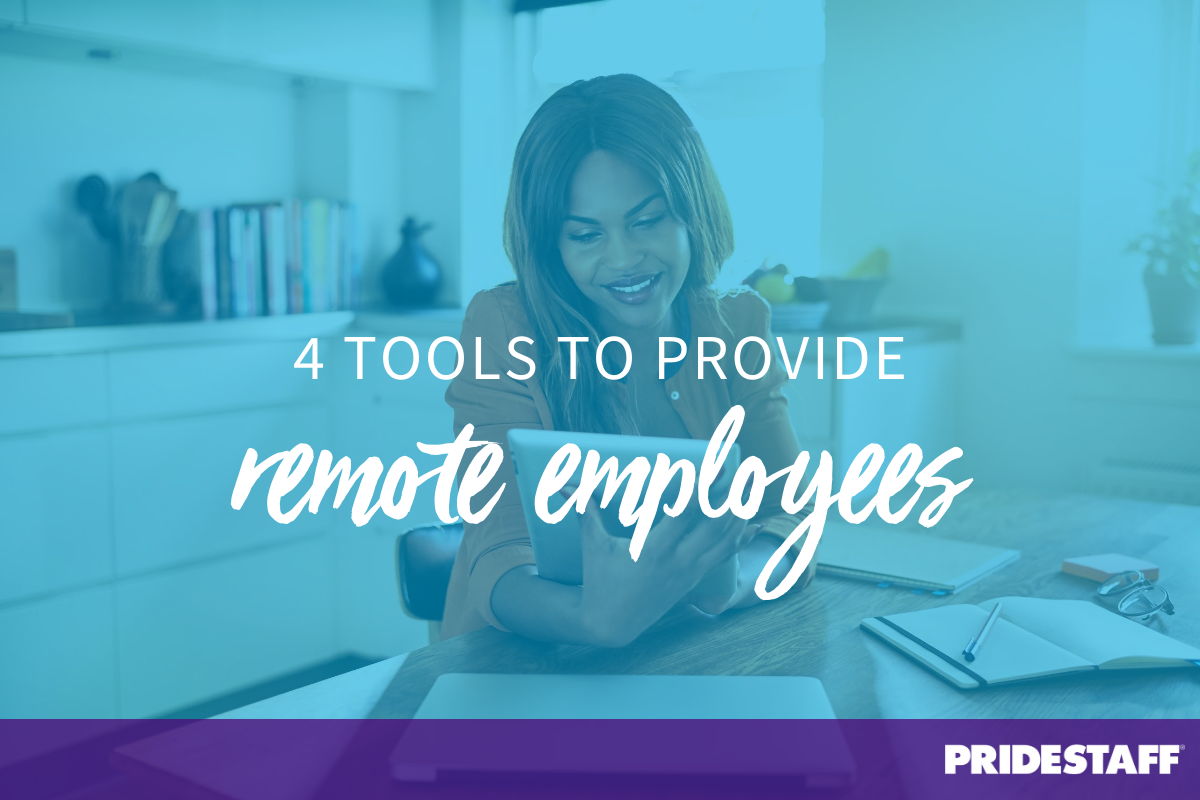4 Tools You Can Provide Remote Employees

Managing a fully remote or blended team?
Then you understand the challenges associated with effectively managing remote workers – including providing the right tech tools to support your team’s engagement, collaboration, and efficiency. While the sheer number of apps, programs, and platforms can seem overwhelming, we’re breaking down four types of remote work tools that are essential for any team – and sharing a few options in each category.
Before you start comparing and selecting tools…
…consult with your IT department or an outside expert. They can help you holistically evaluate your needs to ensure you deploy software that’s appropriate, robust, flexible, and affordable for your organization.
4 Essential Types of Remote Work Tools
1. Screen sharing software.
Whether meeting with clients, customers, or internal teams, collaborative environments call for seamless communication – and sometimes, it’s easier to show than tell. Desktop and screen sharing tools allow your employees to share their screens with others, remote-control other computers, collaborate on projects, videoconference, conduct voice calls, and more. Here are a few options:
- Zoom. This video conferencing solution is incredibly versatile (e.g., group polling, breakout rooms) and has a serviceable free option.
- GoToMeeting. This powerful and unified communications platform integrates well with Office 365 and Google Calendar.
- Join.me. This online screen-sharing solution also has a free option and features customized meeting links, whiteboarding, and audio conference calls.
2. Mobile hotspots.
Reliable internet access is essential for remote employees. A mobile hotspot serves as a backup if an employee’s internet or power goes out. It also provides internet access on the go or in areas where reliable internet isn’t available. When evaluating options, consider your company’s wireless carrier and the number of users, as well as the unit’s battery life, Wi-Fi flexibility (i.e., the hotspot should support both 2.4 GHz and 5 GHz Wi-Fi) and whether USB tethering is available. Here are a few to consider:
- Verizon Inseego Jetpack MiFi 8800L. This dedicated hotspot taps into the largest, and one of the fastest LTE networks in the US.
- GlocalMe G1 Free-Roaming Global Wi-Fi Hotspot. Available on Amazon, this hotspot works in over 100 countries, has an embedded One Cloud SIM card, and requires no contract.
- Nighthawk LET Mobile Hotspot Router. Designed for AT&T users, this hotspot boasts solid 4G speeds on AT&T’s network and has the fastest hotspot hardware currently available.
3. Focus apps.
If employees struggle to stay on task, consider providing them with a tool to limit distractions, and stay focused. Several browser apps and extensions are available to keep your team from getting sucked into Wikipedia entries, YouTube videos, and online shopping rabbit holes:
- Cold Turkey Blocker. Designed for both macOS and Windows, Cold Turkey helps you focus by letting users choose websites and apps to block when it’s time to buckle down.
- Freedom. This all-in-one distraction blocker prevents users from opening extraneous websites they deem distracting on their computer, iPad, or iPhone. It can even be set to block the entire internet (which may be great for focus – but not real-time collaboration!).
- LeechBlock. This Firefox and Chrome browser extension lets the user specify which sites to block, when, and how long. Its timer allows the user to set an amount of time for visiting sites, and then locks them out for the day after time is up.
4. Security tools.
Information security is as important as connectivity for your remote workers – especially for those who must access sensitive information outside the office, and/or store business information on laptops and smartphones. Here are a few of the types of protection you should consider for remote employees:
- Online file backup to prevent data loss
- File and disk encryption to scramble data
- Password managers to protect passwords from hackers
- Multi-factor authentication to add another layer of security and prevent unauthorized account access
- Virtual private networks to create encrypted tunnels for sending and receiving data
PrideStaff is here to help.
Whether your team is on-site, remote, or blended, our national staffing firm is prepared to keep you staffed, flexible, and prepared for what’s next.
How can we help? Contact your local PrideStaff office today to start a conversation.



